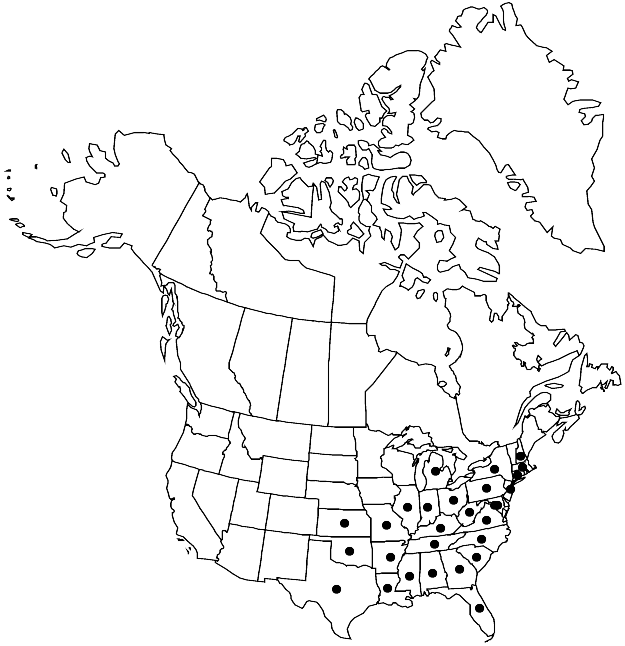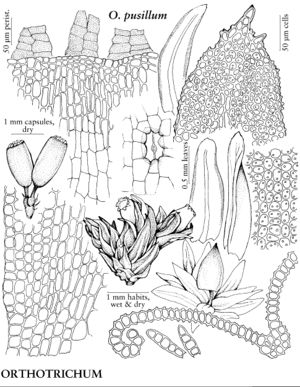Difference between revisions of "Orthotrichum pusillum"
J. Linn. Soc., Bot. 8: 25. 1864.
FNA>Volume Importer |
FNA>Volume Importer |
||
| Line 32: | Line 32: | ||
|elevation=low to moderate elevations (10-1000 m) | |elevation=low to moderate elevations (10-1000 m) | ||
|distribution=Ala.;Ark.;Conn.;D.C.;Fla.;Ga.;Ill.;Ind.;Kans.;Ky.;La.;Md.;Mass.;Mich.;Miss.;Mo.;N.H.;N.J.;N.Y.;N.C.;Ohio;Okla.;Pa.;S.C.;Tenn.;Tex.;Va.;W.Va. | |distribution=Ala.;Ark.;Conn.;D.C.;Fla.;Ga.;Ill.;Ind.;Kans.;Ky.;La.;Md.;Mass.;Mich.;Miss.;Mo.;N.H.;N.J.;N.Y.;N.C.;Ohio;Okla.;Pa.;S.C.;Tenn.;Tex.;Va.;W.Va. | ||
| − | |discussion=<p>Orthotrichum pusillum is distinguished by its smooth, oblong capsules sharply contracted to the seta, 16 exostome teeth erect or recurved when old, some leaves of each plant having 1–4 small denticulations at the apex, and distal laminal cells 9–14 µm. The laminal cells are smaller than those of O. pumilum and in longitudinal rows, but they are larger, with thinner walls, than those of O. ohioense. Orthotrichum pusillum has a denticulate leaf apex that may be narrowly obtuse or acute, and laminal cells 9–14 µm with thin walls; O. pumilum has an apiculate leaf apex that is normally acute and entire, and laminal cells 14–20 µm with thin walls; and O. ohioense has an obtuse leaf apex that is never apiculate or denticulate, and laminal cells 8–10 µm with thick walls. Capsules of O. pusillum have stomata at mid capsule or beyond.</p> | + | |discussion=<p><i>Orthotrichum pusillum</i> is distinguished by its smooth, oblong capsules sharply contracted to the seta, 16 exostome teeth erect or recurved when old, some leaves of each plant having 1–4 small denticulations at the apex, and distal laminal cells 9–14 µm. The laminal cells are smaller than those of <i>O. pumilum</i> and in longitudinal rows, but they are larger, with thinner walls, than those of <i>O. ohioense</i>. <i>Orthotrichum pusillum</i> has a denticulate leaf apex that may be narrowly obtuse or acute, and laminal cells 9–14 µm with thin walls; <i>O. pumilum</i> has an apiculate leaf apex that is normally acute and entire, and laminal cells 14–20 µm with thin walls; and <i>O. ohioense</i> has an obtuse leaf apex that is never apiculate or denticulate, and laminal cells 8–10 µm with thick walls. Capsules of <i>O. pusillum</i> have stomata at mid capsule or beyond.</p> |
|tables= | |tables= | ||
|references= | |references= | ||
| Line 55: | Line 55: | ||
|publication year=1864 | |publication year=1864 | ||
|special status=Endemic;Selected by author to be illustrated | |special status=Endemic;Selected by author to be illustrated | ||
| − | |source xml=https://jpend@bitbucket.org/aafc-mbb/fna-data-curation.git/src/ | + | |source xml=https://jpend@bitbucket.org/aafc-mbb/fna-data-curation.git/src/8f726806613d60c220dc4493de13607dd3150896/coarse_grained_fna_xml/V28/V28_91.xml |
|genus=Orthotrichum | |genus=Orthotrichum | ||
|species=Orthotrichum pusillum | |species=Orthotrichum pusillum | ||
Revision as of 18:09, 18 September 2019
Plants 0.2–0.4 cm. Stem leaves loosely appressed when dry, ovate-lanceolate to oblong-lanceolate, 1–2.2 mm; margins revolute nearly to apex, entire except for denticulate apex on some leaves; apex narrowly obtuse to broadly acute, sometimes apiculate; basal laminal cells broadly rectangular, walls thin, not nodose; distal cells 9–14 µm, 1-stratose, papillae 2–4 per cell, conic, small. Specialized asexual reproduction by gemmae on abaxial surface of leaves. Sexual condition autoicous. Seta to 1 mm. Capsule immersed to 1/2 emergent, oblong to ovate-oblong, 0.8–1.4 mm, smooth when dry, wrinkled to slightly 8-plicate when old, constricted below mouth when dry; stomata immersed; peristome single; prostome absent; exostome teeth 16, erect or recurved with age, finely papillose, rarely striate at apices; endostome segments usually absent, or 8, rudimentary, of 1 row of cells, smooth. Calyptra oblong, smooth, naked. Spores 13–20 µm.
Habitat: Trunks of deciduous trees in open, dry woods, roadsides, on Juniperus along streams
Elevation: low to moderate elevations (10-1000 m)
Distribution

Ala., Ark., Conn., D.C., Fla., Ga., Ill., Ind., Kans., Ky., La., Md., Mass., Mich., Miss., Mo., N.H., N.J., N.Y., N.C., Ohio, Okla., Pa., S.C., Tenn., Tex., Va., W.Va.
Discussion
Orthotrichum pusillum is distinguished by its smooth, oblong capsules sharply contracted to the seta, 16 exostome teeth erect or recurved when old, some leaves of each plant having 1–4 small denticulations at the apex, and distal laminal cells 9–14 µm. The laminal cells are smaller than those of O. pumilum and in longitudinal rows, but they are larger, with thinner walls, than those of O. ohioense. Orthotrichum pusillum has a denticulate leaf apex that may be narrowly obtuse or acute, and laminal cells 9–14 µm with thin walls; O. pumilum has an apiculate leaf apex that is normally acute and entire, and laminal cells 14–20 µm with thin walls; and O. ohioense has an obtuse leaf apex that is never apiculate or denticulate, and laminal cells 8–10 µm with thick walls. Capsules of O. pusillum have stomata at mid capsule or beyond.
Selected References
None.
